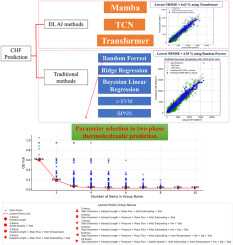The application of deep learning models in predicting complex phenomena such as condensation heat transfer (CHF) has provided significant advancements and insights into the limitations of traditional predictive methods. In a recent study, three distinct deep-learning models were employed, with Transformers emerging as the most effective, thus reinforcing their prominent role in the predictive analytics landscape. This necessitates a reevaluation of input parameters traditionally utilized in past studies, which frequently depended on indirect thermohydraulic measures. These indirect measures often undermine the accuracy of predictions by introducing variability that does not effectively capture the complexity of underlying physical processes.
The success of the Transformer models in this study can largely be attributed to a careful selection of input parameters based on mechanistic analyses, rather than relying solely on historical data trends. This thoughtful approach resulted in a remarkable minimum root mean square percentage error (RMSPE) of 9.85% and a normalized root mean square error (NRMSE) of 6.63%, derived from experimental datasets that exceeded 20,000 points. In contrast, the lookup table (LUT) methodology, which has been a staple in predictive modeling, yielded an alarming RMSPE of 158% and an NRMSE of 21.8%. This stark discrepancy highlights the necessity of employing advanced machine learning frameworks that possess the ability to learn from extensive data input while adapting to new information seamlessly.
As part of this study, five traditional artificial intelligence methods were also evaluated to compare their performance against the deep-learning approaches. The majority of these traditional methods underperformed relative to the LUT method, except for the Random Forest model. The Random Forest model achieved an impressive RMSPE of 3.71% and NRMSE of 4.39%, indicating that while deep learning methodologies are increasingly powerful, certain classical models retain their viability and should be considered when developing predictive workflows.
One vital insight from this research pertains to the sensitivity of predictive accuracy to the number of input parameters utilized. The findings show that the overall deviation (OD) experienced a drastic reduction from 59.75% when a single parameter was used to as low as 2.63% when five parameters were implemented. This suggests that a comprehensive understanding of the parameters influencing the target predictions allows for more accurate modeling. In many practical applications, particularly for small and medium-sized businesses (SMBs), navigating the intricacies of input selection can be a considerable challenge. Properly discerning the most impactful parameters—such as inlet subcooling, which can significantly enhance model accuracy over outlet quality—is crucial.
However, integrating advanced predictive algorithms, particularly in the realm of automation, is not without its challenges. Organizations deploying these technologies often encounter common errors that can undermine their intended effectiveness. Among these errors are API rate limits, which can disrupt data flow between systems, making real-time processing difficult. This issue frequently arises when systems are scaled, and requests exceed predefined limits set by external service providers. To mitigate this risk, businesses should implement robust monitoring solutions to detect and alert on API usage, potentially incorporating exponential backoff strategies to evenly distribute request loads over time.
Another challenge frequently observed within automated systems involves integration issues. Integrating disparate systems can lead to inconsistent data formats and unexpected errors. Establishing standard data protocols prior to implementation can serve as a preventative measure to curb integration-related issues. Businesses can streamline their data ingestion and processing by conducting thorough pre-integration assessments, including creating a detailed mapping of data flows and ensuring all systems can communicate effectively.
For organizations to optimize their return on investment in artificial intelligence, addressing these errors swiftly is paramount. Delays in troubleshooting can lead to poor decision-making, diminished productivity, and negatively impact customer satisfaction. Therefore, it is crucial to establish clear communication channels and protocols among technical teams to ensure that error resolution processes are efficient and documented. In cultivating a proactive atmosphere that emphasizes swift and effective problem-solving, businesses can significantly enhance both their operational efficiency and their confidence in deploying AI-powered solutions.
In conclusion, as businesses continue to strive toward adopting advanced predictive models such as Transformers in areas like CHF testing, recognizing the inherent complexities of parameter selection and integration is essential. Future endeavors should thoroughly investigate multiple predictive techniques, ensuring that the most accurate method is employed amidst the evolving landscape of artificial intelligence. Prioritizing error resolution and implementation best practices will not only enhance predictive capabilities but also yield substantial returns for organizations leveraging these technologies.
FlowMind AI Insight: The strategic integration of advanced AI models requires continuous attention to detail, especially in input selection and error resolution. By establishing proactive measures and clear protocols for troubleshooting, organizations can significantly enhance their predictive performance and operational efficiency.
Original article: Read here
2025-03-01 08:00:00

